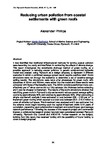Reducing urban pollution from coastal settlements with green roofs
| dc.contributor.author | Phillips, A. | |
| dc.date.accessioned | 2019-05-21T15:53:27Z | |
| dc.date.available | 2019-05-21T15:53:27Z | |
| dc.date.issued | 2018 | |
| dc.identifier.citation |
Phillips, A.. (2018) 'Reducing urban pollution from coastal settlements with green roofs', The Plymouth Student Scientist, 11(1), p. 94-128. | en_US |
| dc.identifier.issn | 1754-2383 | |
| dc.identifier.uri | http://hdl.handle.net/10026.1/14175 | |
| dc.description.abstract |
It was identified that traditional infrastructural methods for solving coastal pollution were becoming too costly and insufficient in combatting the effects of climate change. This report investigates the sustainable drainage method of green roofing as a possible approach to reducing coastal pollution. A generic computational hydraulic model was created, using Plymouth as a design template, to represent 3 different scenarios in which a combined sewage system would require overflow relief. Storm simulations were run through the scenarios to determine a set of baseline sewage spilling results. The simulations were rerun after allowances for green roofs, with substrates of 50mm and 200mm, were added into the model and these results were compared with those of the baseline tests. The 50mm substrate performed more cost-effectively per m2 since storms did not fully saturate this thickness before subsiding and it was far cheaper to implement. The results of the storm simulations showed that retrofitting green roofs in Plymouth’s city centre would reduce coastal sewage spilling counts by approximately 50% and volumes by approximately 66%. After conducting a simple cost-benefit analysis it was estimated to cost between £50 - £100 per m2 to implement green roofing which equated to a total cost between £5.2 - £10.4 million to cover all suitable roof space. This investment was analysed and it was estimated that the scheme would begin returning upon the capital investment within 5-10 years of completion, depending upon collaborative investment and actual impact upon sewage network performance. Following the success of this research project and commercial interest, a collaborative research project has now been considered between Plymouth University, Plymouth City Council and ARCADIS. Further research on the subject, building from this report, has received funding with the possibility of future funding to cover a design proposal. | en_US |
| dc.language.iso | en | en_US |
| dc.publisher | University of Plymouth | |
| dc.rights | Attribution 3.0 United States | * |
| dc.rights.uri | http://creativecommons.org/licenses/by/3.0/us/ | * |
| dc.subject | urban pollution | en_US |
| dc.subject | coastal settlements | en_US |
| dc.subject | green roofs | en_US |
| dc.subject | sewage spillage | en_US |
| dc.subject | storm simulations | en_US |
| dc.subject | sewage system | en_US |
| dc.subject | Plymouth City Council | en_US |
| dc.subject | ARCADIS | en_US |
| dc.title | Reducing urban pollution from coastal settlements with green roofs | en_US |
| dc.type | Article | |
| plymouth.issue | 1 | |
| plymouth.volume | 11 | |
| plymouth.journal | The Plymouth Student Scientist |



